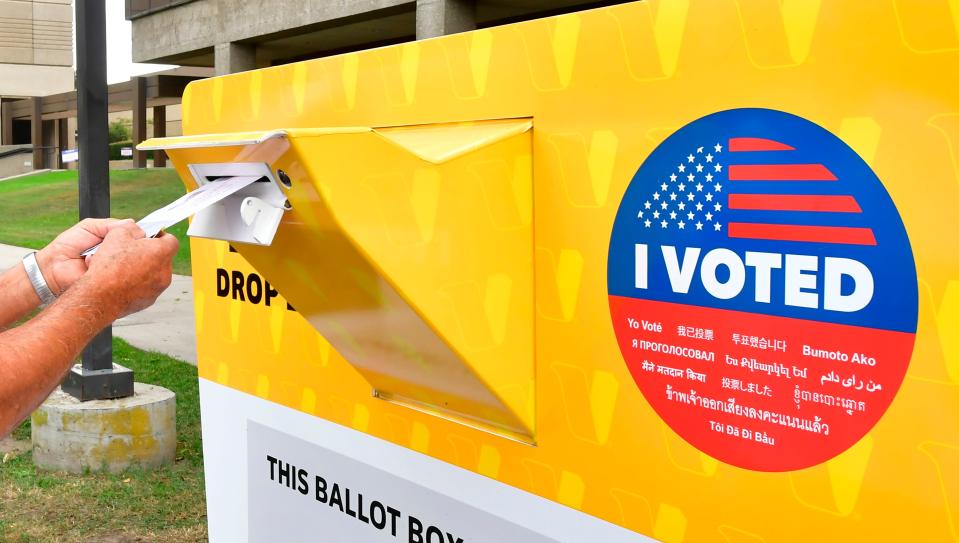Blue payback? Major metropolitan areas in red states could swing the Senate to Democrats
In 2016, nearly all major metropolitan areas voted for Hillary Clinton, including the counties that generate nearly two-thirds of the U.S. economy. In 2018, voters in the nation’s big blue metros returned Democrats to the majority in the House and drove the party’s senate pick-ups in Arizona and Nevada. They also secured gubernatorial victories in several other states. Suburbs in particular played an outsized role in the blue shift.
Our new book — "Blue Metros, Red States" — examines 27 million-plus metropolitan areas in 13 swing states. We find that blue metros maintain a tense political, cultural, economic and demographic relationship with Republican-leaning smaller cities and rural areas in their states. We also find that because of their scale, major metros have the potential to swing statewide elections.
Indeed, polling and early voting leading into Election Day suggest that big city dwellers and their suburban counterparts are spoiling for an assertion of power. Their vote may deliver the Democrats unified control of government by not only voting out President Donald Trump but unseating several incumbent Republican senators.
Suburbs could realign US politics
Consider Texas, a state that has not voted for a Democratic statewide office holder since Ann Richards in 1990. But Texas is changing in a big Texas-style way. Driving the blue shift are five mega counties — Bexar (San Antonio), Dallas, Harris (Houston), Tarrant (Fort Worth), and Travis (Austin). The “big five” contain about 13.5 million residents, or nearly half the state’s population. They swung strongly toward the Democrats in 2018, when Senate Democratic challenger Beto O’Rourke won all five and nearly beat incumbent Republican Ted Cruz.
There are eight 2020 Senate races in the 13 swing states our book covers: two in the Midwest (Michigan and Minnesota), four in the South (North Carolina, Texas and two in Georgia), and two in the Mountain West (Arizona and Colorado).

In Michigan and Minnesota, the Democratic incumbents are likely to prevail. However, current polling indicates that the GOP’s prospects for holding the other seats ranges from unlikely (Arizona, Colorado and North Carolina) to tenuous (both Georgia seats), with only Texas being a likely Republican hold.
Election night: If we are patient, election will deliver peaceful transfer of power
If some or all of these Republican-held Senate seats flip, it will be because the Democrats will have pushed the party’s support far enough into the suburbs of million-plus metros to overcome the GOP’s outsized margins in small cities and rural areas.
Certainly, the Democrats have other opportunities to gain the Senate majority by flipping seats in less urban states such as Iowa, Maine, Montana, South Carolina, and even Alaska. However, the suburban revolt brewing in swing states with major metros against the Republican Party has the potential to realign American politics.
Newcomers with blue-state views
For decades, the GOP successfully split the suburbs from their urban cores. As a consequence, suburban voting patterns were more aligned with outlying rural regions rather than more big cities. This, in turn, advanced policy agendas often hostile to big metro interests.
What changed? The fastest-growing suburbs are rapidly diversifying and support denser mixed-use projects and rail transit — environments that often appeal to Democrats. In many states, suburbs attract transplants from liberal enclaves in California and the Northeast who may bring blue state politics with them. These dynamics are particularly salient in major Sun Belt metros.
Voting: At 87, all my mom wanted was to vote in this election
The COVID-19 pandemic reinforced metros versus rest-of-state dynamics by pitting big cities and their suburbs against Republican governors and the Trump administration. Along with Trump’s continued attacks on big metros, this helped fortify the urban-suburban versus exurban-rural divide in a way benefiting Democrats.
Our book shows that —regardless of state or region — denser and more diverse places in major metros generate greater Democratic support. Having incoming Democratic senators who owe their victories to major metros may not just switch partisan control, but also give urban America a stronger voice in a body that by design often promotes the interests of smaller rural states.
The authors of this column teach at the University of Nevada, Las Vegas. David F. Damore is a Professor of Political Science, Robert E. Lang is the Lincy Endowed Chair in Urban Affairs and Karen A. Danielsen is an Associate Professor of Public Policy and Leadership.
You can read diverse opinions from our Board of Contributors and other writers on the Opinion front page, on Twitter @usatodayopinion and in our daily Opinion newsletter. To respond to a column, submit a comment to letters@usatoday.com.
This article originally appeared on USA TODAY: Senate and elections: the shifting demographics may change outcomes

